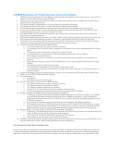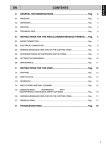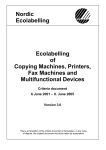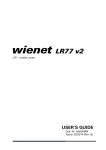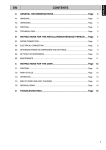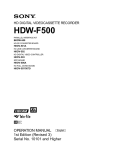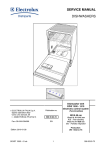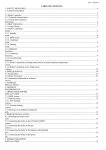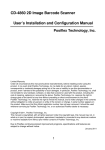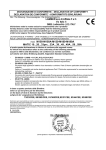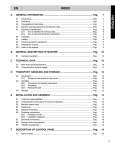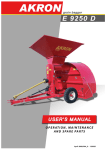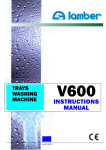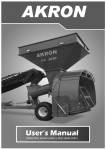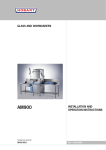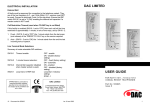Download User Manual
Transcript
EN GENERAL INSTRUCTIONS 1. Read carefully the contents of this manual as it contains important safety information regarding the installation, use and maintenance of the appliance. Keep this manual in a safe place for the eventual use by other operators. 2. The installation of this appliance must be carried out by qualified persons in accordance with the manufacturer’s instructions. 3. This appliance should only be used by persons specifically trained in its operation. 4. Switch off the appliance in the case of failure or irregular running. Have the appliance repaired by a technically qualified person authorized by the manufacturer and using original spare parts. If the above is not respected the safety of the appliance could be jeopardized. INSTRUCTIONS FOR THE INSTALLER The installation of this appliance must be carried out according to the standards and regulations in force. Radio interference. This appliance conforms to the E.E.C. guideline 87-308 relating to radio interference suppression. Legend fig. 1a/1b A - Water inlet pipe with ø3/4" F pipe fitting B - Power supply cable C - Drainage pipe ø18 mm int.(if with pump) D - Drainage pipe ø40 mm int.(if without pump) E - Equipotential screw (earthbonding) Positioning • Place and connect the appliance referring to the installation drawing. • Bring the appliance level by rotating the adjustable feets. Connection to the water supply • Connect the appliance water pipe "A" (fig. 1a/1b) to the mains supply, installing a valve, pressure gauge, filter (supplied) and a double non-return valve "B" (supplied) in between, as shown in fig. 10. • Make sure to tighten all the parts. CAUTION Data plate The data plate is located on the right-hand side panel of the appliance. If the appliance is replaced, use the new feed pipe supplied. CAUTION CAUTION This machine must be installed in accordance with AS/NZS 3500.1 including the installation of a non-integral backflow prevention device. In case of water pipe replacement, make sure the nonreturn valve "B" (fig. 10) and the filter supplied are correctly fitted, as shown in fig. 10. TECHNICAL DATA • Singlephase version Power supply voltage: Maximum power input Boiler heating elements Threephase version Power supply voltage: - convertible to Maximum power input Boiler heating elements Frequency Tank heating elements Water supply pressure Water supply temperature Water supply hardness: - without softner - with softner Water consumption per rinse cycle (at 180 kPa) Boiler capacity Tank capacity Standard cycle time with water supplied at 15 - 20°C Standard cycle time with water supplied at 65°C Max. hot water pressure inside the appliance Max. hot water temperature inside the appliance Power supply cable Power cable cross section in mm2: • Singlephase version 230 V 1N~ • Threephase version 400 V 3N~ • Threephase version 230 V 3~ Maximum current leakage Noise level Net weight, version h= 635 mm Net weight, version h= 715 mm Degree of protection (*) Models with a single wash cycle (**) Only for NGWDPDD (***) Only for NGWGMS 6 V kW kW kW kW 230 1N~ 3,3 2,3 (**) 3,0 2,0 (**) V V kW kW Hz kW kPa °C °C 400 3N~ 230 3~ 4,8 4,5 50 or 60 0,8 180 - 300 15 - 20 65 (***) °F 15 max °F 34 max l 2,3 l 4,7 l 6 sec. 120 - 300 sec. 120 (*) sec. 60 (*) (***) kPa 600 °C 82 H07RN-F 3 x 1,5 5 x 1,5 4 x 2,5 mA/kW dB(A) Kg Kg IPX 1 <70 40 46 4 • • • Check that the dynamic water supply pressure, measured between the appliance and the mains, has a rating of between 180 to 300 kPa during the rinse cycle; on units that are not provided with, an electric pump, available as an accessory, should be fitted into the hidraulyc circuit in case the pressure rating is below than required. On freefall drainage models: connect the appliance drainage outlet "D" (fig. 1a/1b) to the drainage system either by using a syphon or by placing the appliance over a drainage syphon-well into the pavement. On models with a drainage pump: position the drainage pipe "C" (fig. 1a/1b) at a height of between 750 and 1000 mm from the pavement. Check that about 2,3 litres of water flow out of the drainage pipe during the rinse cycle. ELECTRIC CONNECTION • Before carrying out the electrical connection, make sure that the voltage and frequency rated on the appliance data plate conforms to those of the mains supply. • The earth wire of the power supply cable must be connected to earth. The appliance must be included in a correctly dimensioned equipotential system. The connection should be carried out using the screw "E" (fig. 1a/1b) marked with the symbol "E". The equipotential wire must have a section of at least 10 mm2. • For the eventual conversion from 400V 3N~ to 230V 3~, proceed as follows: - Add the endowed jumper "B" (fig.2), between the binding posts "L1" and "N" of the connection terminal block placed behind the machine. • Replace the power supply cable with a 4 x 2.5 mm2,type H07RN-F. Change the connection of the boiler heating element, as shown in the electrical wiring diagram. The appliance must be connected to the mains through a suitable general circuit breaker, which must leave a gap of at least 3 mm between its contacts and have the current carrying capacity as indicated in the following table: Max. power consumption 4,8 kW 4,8 kW 4,8 kW Power supply voltage 230 V 1N~ 400 V 3N~ 230 V 3~ Current carrying capacity 25 A 1P+N 16 A 3P+N 16 A 3P The chosen device must be lockable in the open position in case of maintenance. The manufacturer accepts no liability for situations arising from failure to comply with the safety rules. Detergent dispenser adjustment (if provided in the machine) To vary the dose, adjust the screw "L" (fig. 4) as required. The adjustment of the amount of detergent delivered by the pump must carefully comply with that indicated by the detergent producer. This quantity is usually expressed in g./l and various depending on the water hardness. Setting the automatic rinse aid dispenser Adjust the screw “D” (fig.4) to set the required dose. To check the efficiency of the rinse aid look at a freshly washed glass. Drops of water on the glass indicate an insufficient dosage while streaks indicate an excessive dosage which can either be caused by the density or the quantity. Changing the detergent/rinse-aid type. If changing to a different detergent/rinse-aid type (even one by the same manufacturer), you must rinse the suction and pressure hoses with fresh water before connecting the new detergent/rinse-aid container. Otherwise, the mixing of different types of detergent/rinse-aid will cause crystallisation, which may result in a breakdown of the dosing pump. Failure to observe this condition will invalidate the guarantee and product liability. Safety devices • An automatically resetting thermoamperometric protection incorporated into the winding of the electric pump cuts off the power supply in case of anomalies or malfunctioning. • A safety thermostat, which must be reset manually, cuts off the power supply to the boiler heating elements in case of over heating. • An overflow pipe, connected to the drainage outlet, maintains the water in the tank at a constant level. • On models with a drainage pump and two wash cycles: a supplementary level control device will intervene if the main level control device is faulty. INSTRUCTIONS FOR THE USER The appliance must be used exclusively for the purpose for which it has been made: this means for washing dishes using water and specific non corrosive detergents. Any other use is therefore to be considered improper. Water softner “A” (fig.5), if provided The softner removes the calcareous substances from the feed-water, supplying decalcified water necessary for the washing. For the correct operation of the softner, the periodical regeneration of the resins, whose frequence depends on the number of washing cycles and water hardness, must be carried out. The regeneration of the resins is carried out by means of a special regeneration cycle with coarse salt or specific products for softners following the instructions described in chapter “Regeneration cycle”. Suggestions • Carry out a couple of wash cycles without dishes to clean the basin and piping of any protective or industrial grease which has remained. • Avoid washing decorated crockery. • Do not allow silverware to come into contact with other metals. • Do not allow food residue to dry on the dishes. • Remove large food scraps from the dishes in order to prevent the filters from clogging. • Prewash the dishes by spraying them with cold or lukewarm water. • Use the quantity and type of detergent specified by the detergent manufacturers. Adding the detergent Pour a non foam making detergent into the basin when the water has reached the right washing temperature. Loading the baskets (fig.6 - 8) • Place cups and glasses of different dimensions up side down in the supplied basket, using ev. the special cutlery container (fig.6 a-b). • Some cup washer models have a wire basket for glasses with inclined bottom. The glasses must be placed upside down (fig. 8a). • For dishwashers with a 715 mm height: the special plates basket where 16 plates with a max. diameter of 190 mm or 8 plates with a max. diameter of 240 mm can be placed (fig.7), is available on request. Note Baskets for washing dishes which have non standard shapes and dimensions are available on request. Control panel legend (fig.9) A - Indicator lamp, lights up when the appliance is live. B - Ignition switch of the appliance, ON /OFF. C - Cold rinsing push-button/switch. D - Indicator lamp, lights up when the regeneration cycle is in progress. E - Softner regeneration switch. F - Basin drainage switch / button. G - Switch to select the wash cycle duration. H - Indicator lamp, lights up when the wash cycle is in progress. I - Start cycle push-button. 7 ENGLISH - L - Indicator lamp, lights up when the water has reached the right temperature. Only the letters "A, B, H, I, L" are present in models with one wash cycle and without drain pump. Only the letters "A, B, F, H, I, L" are present in models with one wash cycle and with drain pump. WASH CYCLES - Short cycle, 120 seconds: it corresponds to a 100 second wash cycle with hot water and detergent, a pause of 4 seconds and a 16 second rinse cycle with hot water and shining product. - Short cycle, 60 seconds: it corresponds to a 40 second wash cycle with hot water and detergent, a pause of 4 seconds and a 16 second rinse cycle with hot water and shining product. - Long cycle, 300 seconds: for dirty dishes: it corresponds to a 280 second wash cycle with hot water and detergent, a 4 second pause and a 16 second rinse cycle with hot water and shining product. • In models with two wash cycles, cycle selection occurs with button “G” pressed for the 300-second cycle and off for the 120-second cycle. • In models with single wash cycle (120 sec. or 60 sec.), cycle selection occurs with button “I”. • To stop the wash cycle just open the door. • To continue washing, close the door and the cycle will resume from where it was stopped. SWITCHING ON • Open the water inlet valve. • Activate the main switch. • Open the door and check that all the components are in their correct position. • Close the door and ignite the appliance by pressing switch "B". The lighting up of the indicator lamp "A" shows that the dishwasher is live and that the water loading and heating cycle has started. • Lighting up of the indicator lamp "L" signals that the tank and boiler have reached the optimum temperature (tank 50°C and boiler 82°C). Open the door and pour the required amount of detergent into the basin. • Insert the basket containing the dirty dishes and close the door. • Select the duration of the cycle by means of switch "G" (inserted for a 300 seconds cycle or disconnected for a 120 seconds cycle). • Should the dishwasher be provided with the cold rinse setting, insert switch "C" for the washing of glasses which have to be used cold, directly. In model NGWGMS, the cold rinse function occurs by holding down push-button “C”. • Start the cycle by pressing the start push button “I”. The dishwasher starts automatically the wash cycle with a 3 second delay and the indicator lamp “H” lights up. • The indicator lamp “H” will go off when the cycle is complete; open the door and slide-out the basket with the clean dishes. CAUTION Change the water in the basin some times a day, as soon as necessary. 8 At the end of the working day • Open the door and slide-out the basket with clean dishes. • Turn off the dishwasher disconnecting switch "B". • Disconnect the main switch placed upstream from the appliance. • Close the water inlet valve. • Remove the overflow pipe "A"(fig.4). For models with drainage pump: • Open the door and slide-out the basket with clean dishes. • Remove the overflow pipe and re-close the door. • In models with two wash cycles, insert switch "F" and press push button "I"; indicator lamp "H" will light up and the dishwasher will drain the water from the basin activating the drainage pump for about 120 seconds. The indicator lamp "H" will go off when the drainage function has finished. • In model NGWGMS, insert switch "F" and press push button "I"; indicator lamp "H" will light up and the dishwasher will drain the water from the basin activating the drainage pump for about 60 seconds. The indicator lamp "H" will go off when the drainage function has finished. • In models with one wash cycle, keep button "F" pressed until the tank is completely empty. • Turn off the dishwasher disactivating switch "B". Regeneration cycle, for models with softner: The regeneration cycle of the resins of the softner lasts for 20 minutes (18 minutes of regeneration and 2 minutes of rinsing). The frequence of the cycle depends on the number of wash cycles and the feed-water hardness as described in the table 1. CAUTION The relevant water supply company will be able to provide all the instructions regarding the water hardness. • • • • • • Open the door, remove the basket and the overflow pipe and drain the water. Open the salt container “B” (fig.4) by unscrewing the cap. Fill it with salt for softners or coarse salt up to 2-3 cm from the upper edge (make shure the container is filled with water before pouring any salt inside). Clean the thread of the container from any salt deposits before closing the cap. Remove the salt from the basin if it overflows the container. To activate the function, insert the regeneration switch “E” with dishwasher live. The indicator lamp "D" lights on during the cycle and the other functions cannot operated. The indicator lamp “D” lights off indicating the end of the regene-ration cycle; switch off the dishwasher disactivating switch “B”, and disactivate successively switch “E”. Upon completion of cleaning operations, replace the parts removed previously. The dishwasher is now ready to start the normal working functions. FREQUENCE in Nr of cycles °F/Nr °F/Nr °F/Nr °F/Nr 10 / 150 17 / 74 24 / 53 31 / 32 11 / 138 18 / 71 25 / 50 32 / 29 12 / 126 19 / 68 26 / 47 33 / 26 13 / 114 20 / 65 27 / 44 34 / 23 14 / 102 21 / 62 28 / 41 * 15 / 90 22 / 59 29 / 38 16 / 77 23 / 56 30 / 35 * If the hardness should exceed 34 °F it is advisable to install a machine without incorporated softner, and to install a separated softner. MAINTENANCE (fig.4) Before carrying out any maintenance operations, turn off the power at the mains (except in versions with drain pump). Daily operations • Cleaning the water jets: - Open the door, and remove the water jets"C" and "E" by removing the lock nut "F". - Carefully clean the washing and rinse jets and clean everything with hot water and neutral detergent/detersive, if necessary using a soft brush or sponge. Do not use sharp implements to clean the nozzle holes, which could otherwise be damaged. • Cleaning the basin: - Remove the overflow pipe "A" to drain off the water from the basin; for models with drainage pump remove the overflow pipe "A", insert the drainage switch "F", press the start push button "I", and wait untill the drainage is complete before switching off the dishwasher. - Remove filter "H" and "I" and clean them in the washbasin, i.e. using a nylon brush under a water spray. - Clean the basin by pouring some water in order to let the deposits flow out from the drain. - Upon completion of cleaning operations, replace the parts removed previously. The dishwasher is now ready to start the normal working functions. • Cleaning the external surfaces: - Clean the stainless steel surfaces using lukewarm water and a neutral soap, rinse with a damp cloth and dry carefully; never use detergents containing scraping agents, common wire wool or other such materials. - Clean the control panel using a soft damp cloth and a neutral detergent if required. • Do not wash the external parts of the machine using direct or high-pressure water jets. • Leave the door open when not using the appliance for a longer period. • Periodically have the appliance totally checked (at least once a year). For this purpose it is recommended to draw up a maintenance contract. Operations to be carried out by a qualified technician • Clean the water filter and the solenoid valve protection filter "P" at least twice a year (fig. 11). • Descale the boiler, the internal surfaces of the basin and the hydraulic piping once or twice a year. • Whenever the appliance is not going to be used for long periods, spread a thin film of vaseline oil over the stainless steel surfaces, drain off the water in the electric pump. • The tube inside the peristaltic detergent dispenser (if present in the machine) must undergo periodical maintenance (once or twice a year). • Disconnect the machine power supply. RESIDUAL RISKS The machine has several risks that were not completely eliminated from a design standpoint or with the installation of adequate protection devices. Nevertheless, through this manual the Manufacturer has taken steps to inform operators of such risks, carefully indicating the personal protection equipment to be used by them. Sufficient spaces are provided for during the machine installation phases in order to limit these risks. To preserve these conditions, the corridors and areas around the machine must always be: • kept free of obstacles (e.g. ladders, tools, containers, boxes, etc.); • clean and dry; • well lit. For the Customer’s complete information, the residual risks remaining on the machine are given below; such actions are to be considered incorrect and therefore strictly forbidden. RESIDUAL RISK DESCRIPTION OF HAZARDOUS SITUATION Slipping or falling The operator can slip due to water or dirt on the floor. Burns The operator deliberately or unintentionally touches some components inside the machine or dishes at the outfeed without using gloves or without allowing them to cool. Possible contact with water above 60°C / 140°F. Electrocution Contact with live parts during maintenance operations carried out with the electrical panel powered. Falling from above The operator intervenes on the machine using unsuitable systems to access the upper part (e.g. rung ladders, or climbs on it). Tipping of loads During maintenance on the machine or the packing containing the machine with the use of unsuitable accessories or lifting systems or with load unbalanced. Chemical Contact with chemical substances (e.g. detergent, rinse aid, scale remover, etc.) without taking adequate safety precautions. Therefore always refer to the safety cards and labels on the products used. CAUTION Descale the rinse jets each month using vinegar or a descaling agent. 9 ENGLISH Table 1 - WATER HARDNESS in °F / REGENERATION TROUBLESHOOTING DISHWASHER DOES NOT WASH WELL 1. Check if the suction filter is dirty and clean it thoroughly. 2. Check if the wash jets are clogged by solid food remains. 3. Check that the initial amount of detergent or subsequent additions are correct. 4. The selected wash cycle is too short. Repeat the cycle. 5. Check that the tank temperature is between 55°C and 65°C. 6. Check that the dishes are stacked correctly in the racks. GLASSES AND DISHES ARE NOT DRIED PROPERLY 1. Check the instructions for the amount of rinse-aid (see “setting the dispensers” paragraph). 2. Check that there is rinse-aid in the container and if necessary top up. 3. Check the set amount of rinseaid (see “setting the dispensers” paragraph). 4. Check that the water temperature is between 80°C and 90°C. CONDENSATION ON GLASSES 1. Check that there is rinse-aid in the container and if necessary top up. 2. Check the set amount of rinseaid (see “setting the dispensers” paragraph). 3. Remove the rack of glasses immediately the cycle has ended. STAINS ON THE GLASSES 1. Only use “non-foaming” products for professional dishwashers. EXCESSIVE FOAM IN THE TANK 1. Check that the wash water temperature is not less than 50°C. 2. Check if the amount of product dispensed by the detergent dispenser is excessive (see “setting the dispensers” paragraph). 3. Ensure that the tank has not been cleaned with unsuitable cleaners. Drain the tank and rinse thoroughly before new wash cycles. 4. If a foaming detergent has been used, drain and refill the tank with water until the foam disappears. SMEARS OR SPOTS ON THE GLASSES 1. Reduce the amount of rinse-aid (see “setting the dispensers” paragraph). THE WASH OR RINSE ARMS TURN SLOWLY 1. Remove and thoroughly clean the arms. 2. Clean the wash pump suction filter. 10





